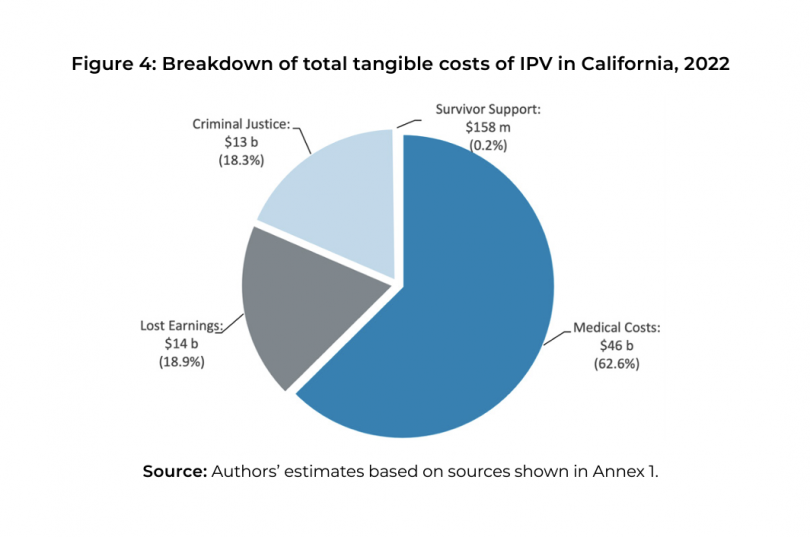Intimate partner violence (IPV) costs the state of California approximately $73.7 billion annually, due to costs associated with health care for victims, policing and the criminal legal system, and response programs, as well as the indirect cost of loss of income for those involved, according to a new report from UC San Diego’s School of Medicine and the Newcomb Institute at Tulane University.
Out of that $73.7 billion, the report estimates CA spent or lost in 2022, medical care accounted for $46 billion (62.6%), lost earnings made up $14 billion (18.9%), and criminal justice system costs amounted to $13 billion (18.3%), while the state spent $158 million (or 0.2%) on support for survivors.
To break the numbers down in a different way, domestic violence costs $88,000 per victim.
“These costs are being borne by individual survivors and victims and their families, by employers, and taxpayers,” the report authors point out.
Data from the 2023 California Violence Experiences Survey (CalVEX), a statewide survey on violence, revealed that one in 16 people in California experienced intimate partner violence — emotional, physical, or sexual violence from a current or former partner — in the past year. And an estimated half of women in California will experience such violence in their lifetime.
Additionally, according to the survey, people identifying as lesbian, gay, bisexual, or another sexual identity, people of color, individuals with disabilities, and people with less than a high school diploma, as well as respondents with a history of homelessness or incarceration were more likely to report having experienced IPV in the last year than their peers.
The report recommends “a consistent and sustainable funding stream” in the state budget for preventing and responding to domestic violence.
“With significant reduction in federal funds in 2024, California is expected to decrease expenditures supporting survivors of domestic and sexual violence dramatically; key disbursements for victims’ services were omitted from the state’s preliminary budget for the 2024-2025 fiscal year,” the report authors note. “This is disappointing since evaluations have shown these programs work.”
The federal Victims of Crime Act (VOCA) distributes money to community-based organizations working with survivors in need, and to states for direct financial assistance for victims. Because the funding relies on fines and fees levied against people convicted of crimes, and is not supported by tax dollars, states are getting far less money deposited into their victim compensation funds.
Victim services in California will receive $87 million for fiscal year 2024 — a reduction of approximately 43% from the $153.8 million allocated the previous year, according to the California Partnership to End Domestic Violence. The partnership expects this financial downshift to lead to more homelessness and housing instability, as well as reductions to mental health services for survivors of IPV.
Improving data collection and analysis regarding outcomes and consequences is also critical to shaping laws and developing strategies for addressing IPV, according to the report authors, who pointed out that significant gaps in state-level data made it difficult to write their report.
The report also calls for better compliance with existing firearm legislation blocking people with domestic violence convictions from firearm use. “Many Californians— especially men—regularly obtain guns without registering them,” the report notes.
Additionally, the authors recommend the development of “intersectional IPV policies and practices that attend to the ways gender, race, ethnicity, sexual orientation and socioeconomic status” relate to IPV. “More fine grained data would allow for an assessment of the disparate costs faced by different communities across California and allow for resources to be concentrated in areas communities that benefit from them the most.”


“a consistent and stable funding stream” that’s the whole point isn’t it? And like racism it can never be solved, because they’d loose the “consistent and stable funding stream” and that is most definitely not the point.
Hey Taylor,
Avoiding the semantics associated with the whole “gender identity” phenomenon…. you reference men “regularly obtain guns without registering them”. Why not dig a little deeper? How many of those “unregistered guns” are used in IPV when compared to other types of violent crimes? Or, why not write an article about how many of those “unregistered guns” are obtained (including ghost guns) by convicted felons who are no longer eligible to own firearms?
Since you won’t respond, I’ll give the honest answers to those questions. The extreme vast majority of those unregistered firearms are used by thugs in street crime. Also, the extreme vast majority of law-abiding citizens continue to follow the increasingly difficult regulations in order to procure firearms in this circus of a state.
It doesn’t matter what laws progressives pass…. these weapons will always be in the hands of those who laugh at your efforts. Rather than chase your unicorn, I’d rather encourage victims and those who fear being victimized to arm and defend themselves.